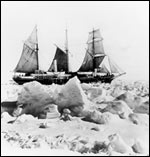|

The Endurance: Shackletons
Legendary Antarctic Expedition brings to
life one of the greatest tales of survival in exploration
history: the epic story of Shackleton's 1914 voyage.
Through diary entries, rare film footage, and 150
extraordinary images by ship photographer Frank
Hurley, the exhibit resurrects the forbidding panoramas
of Antarctica, the bravery and camaraderie of a
valiant crew in extreme adversity, and the miraculous
climax of their journey. It is a story that "more
than 80 years later, still leaves one gasping,"
says author and exhibit co-curator Caroline Alexander.
 |
Before
the Endurance: The Heroic Age of Antarctic Exploration
Ernest Henry Shackleton was 27 years old and
an officer in the British Merchant Navy when
he volunteered for Captain Robert Falcon Scotts
1901 Discovery
expedition to the South Pole, which launched
the Heroic Age of Antarctic Exploration. Though
unsuccessful, the journey gave Shackleton a
taste for adventure and strengthened his own
ideas on how to lead an Antarctic expedition. |
By
1907, Shackleton had raised enough money to
lead his own expedition on the ship Nimrod
to the South Pole. But on the continent, only
100 miles from the South Pole, Shackleton noted
his crews terrible conditionsnow-blindness,
hunger, frostbite, and waning suppliesand
he made the heartbreaking decision to turn back.
A courageous leader who always put his men first,
Shackleton returned to England a national hero
and was knighted.
His third foray south came in 1914, in the wake of the tragic death of Scott,
who had failed in his attempt to beat Norwegian Roald Amundsen to the South Pole.
Because England had lost the attainment of both poles to the Norwegians, Shackleton
was determined to claim the last prize in polar exploration: crossing the Antarctic
continent on foot.
|
 |
He purchased a 144-foot-long wooden barquentine named
Polaris, which he renamed
Endurance for his family
motto: Fortitudine Vincimus
(by endurance we conquer).
Read More... |